
table of contents
- Climbing plants
- Perennial species
- Blackberries
- Bougainvillea
- Clematis
- Wild Wine
- Star jasmine
- Annual species
- Nasturtiums
- Climbing roses
Climbing plants are a magnificent sight in the garden and inspire even in pots with their fascinating growth. While ivy only blooms in the age form and climbing spindles have fruits and perennial adherent roots, there are Annual and perennial climbing plants that also bloom and seduce with colorful flowers and an intense scent want. They can decorate the house wall, be used as a privacy screen or to attract insects.
Climbing plants
Climbing plants are more than just ivy
It is true that the ivy with its flowers also belongs to the perennial group from an age of more than ten years Climbing plants, which is also fast growing, yet there are so many species that lack the spotlight Experienced. Those who want to enjoy tropical blooms should choose passion flowers, while Japanese hops can also grow in the shade with their five-fingered leaves. There are numerous climbing plants that are suitable for gardens, house walls, trellises or as a container plant and accentuate the garden with their splendor of flowers. They are either perennial or annual, even evergreen climbing plants that can be perfectly integrated into the garden or on the balcony.

Perennial species
Seven perennial species for artistic garden projects
The majority of the climbers available in Germany are perennial and the majority of them are hardy and therefore well suited for cultivation in domestic gardens. Decorative growth forms and glowing flowers present themselves and even enchant with wonderful fragrances that immediately rise in the nose on long summer evenings. It is fascinating to see how different the plants are in their properties and none of them are the same as the other. This is why they are so popular with gardeners, in parks, gardens, and landscaping as they are one A privacy screen that has been growing for decades or a solitary container plant that attracts everyone's attention draws itself.
Blackberries
Blackberries (Rabus section Rabus) are not only known for their berry fruits, but also for their flowers, which bees and other pollinators like to visit. They love to be in the sun and need a rhizome barrier because they sprout strongly and can take over the garden. The best location is on a wall out of the wind and the trellis should be about two high Meters and have about five taut wires on which the plant can climb can. While you can enjoy the flowers in summer, the autumn harvest is a highlight.

Banderilla
Banderilla is also known as Dipladenia and these tropical dog poison plants love full sun and are not winter-proof, but a perennial plant. Of the four species that are available in Germany, only Mandevilla laxa is winter-proof down to -10 ° C. The other varieties cannot withstand this and have to be overwintered.
- Dipladenia Mandevilla sanderi
- Mandevilla boliviensis
- Mandevilla x amabilis
The large flowers of the Dipladenia in white to pink and the dense, local growth make this climbing plant from South America the perfect exotic. A highlight of the plant are the loops at the end of the shoots that show up in summer, followed by beautiful flowers that fit perfectly into a Mediterranean garden.

Bougainvillea
Bougainvillea is also a tropical exotic that is perfect for keeping in a bucket. The triple flower has numerous varieties and these can all be grown in pots as long as it has a light, cool and wind-protected winter quarters available. It can be kept on the balcony without any problems and prefers a lot of sun and warmth. It forms large quantities of white, yellow or blue-purple flowers that can be used as a breathtaking eye-catcher. Keeping the plant in a bucket requires a trellis, for example from bamboo.
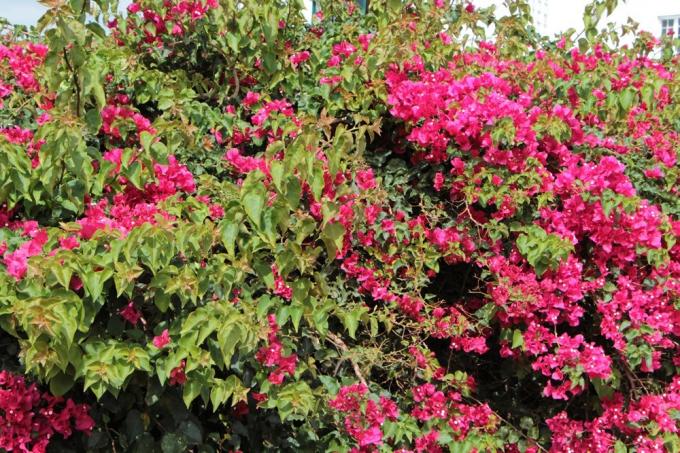
Passion flowers
Passiflora The name was given because Christian missionaries were reminded of the Passion of Jesus Christ due to the blossom, which looks very peculiar compared to the European flowers. But the blue Passiflora caerulea is particularly popular in Germany. This perennial plant loses all of its leaves in winter, but can safely and with a vigorous Winter protection from leaves and wood shavings near other hardy shrubs brought through the cold season will. The highlight of it is its lush blooms and the possibility of growing it in a tub.

Clematis
Clematis or clematis are a species-rich genus of buttercups that are enthusiastically planted because of their flowers. It comes in many colors and heights and is one of the few climbing plants that not only like it sunny, but also shady. This mainly refers to the foliage, which like it sunny, while the roots love shade. This should definitely be taken into account with the location, otherwise the growth will suffer. They also form tendrils and are therefore often attached to walls, arches or overhangs. Some of the most beautiful species of clematis for the garden are as follows.
- Clematis Apollonia
- Clematis Ashva
- Clematis alpina
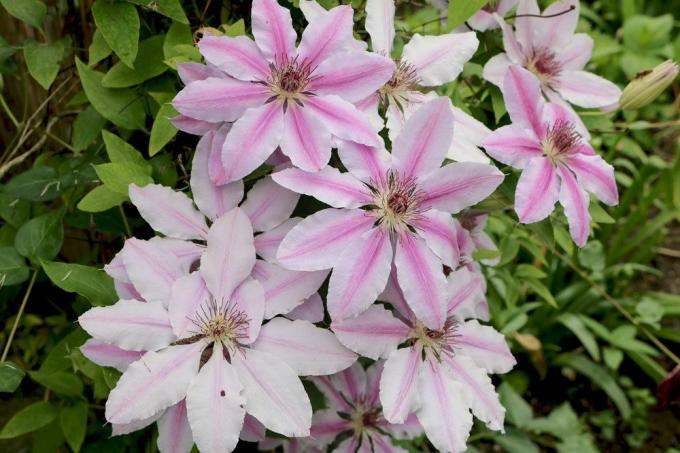
Wild Wine
The wild wine or Vitis vinifera is a vine that is one of the strong shooters and must be kept in check with a rhizome barrier. The wild wine lignifies over the years and can reach heights of five to an incredible 40 meters if it is not cut. This climbing plant can actually be attached anywhere, is fast-growing and likes to expand. The leaves of the self-climber are reminiscent of grapevines and can be over 50 years old and, like ivy, quickly becomes a problem for facades and others without the necessary pruning Trees. The numerous small flowers are close together and stand out against the green of the leaves.
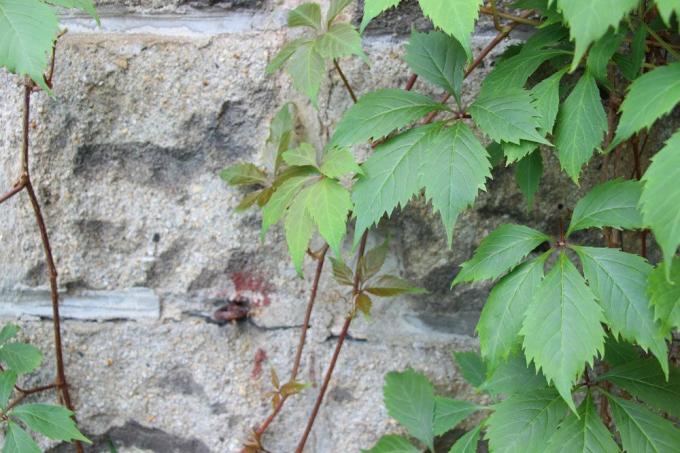
Star jasmine
Trachelospermum are evergreen, woody climbing plants that form lianas and can easily withstand winter down to -5 ° C in Germany. The Asian tropical plant secretes a milky sap that is popular with insects. In addition to plenty of sun and high humidity, winter quarters are necessary if you live in the colder regions of Germany. Unique and popular about star jasmine are the white flowers, which are shaped like a pinwheel and when it grows extremely lush, it is related to oleander clearly recognizable. Star jasmine is simply a splendor in the garden, which can also be kept in the bucket via a suitable trellis.

Note: When keeping a perennial climbing plant, always make sure to cut it regularly and choose the correct location. In this way you can prevent overgrowth and damage to trees or facades that serve as a substrate for perennial climbing plants.
Annual species
Four annual climbing plants with that certain something
The annual climbing plants also have beautiful species that are not as common as the perennial climbers, but enchant with their own species. Compared to the perennial plants, their flowers are not as strong and slightly smaller, but with these species you never run the risk of becoming overgrown. They pass in winter and can be grown again the next year. On the other hand, they sprout extremely strongly over the spring and summer and can take on attractive sizes within a short time.
Nasturtiums
This annual climbing plant is easy to care for and can often be found in Germany. The plant can easily be grown in pots, is quite undemanding and inspires in summer with an appealing number of flowers that are presented in warm colors. The medicinal plant of 2013 was the great nasturtium. The styles have a pungent taste that is made up over the mustard oils they contain. The cress can climb perfectly over a climbing aid and is even very high as a result. It does not need any fertilizers and the flowers lie between the leaves like in a flowerbed.

Sweet peas
Sweet peas (Vicia) draw attention from afar with their lush flowers. As an annual herbaceous climbing plant, it forms small flowers in different colors and likes to wrap itself up on other plants or over climbing aids and bars on walls or fences. In addition, there are the Lathyurs, also vetches, which are also a climbing plant, but do not grow as lush and tall. Known as fragrant flat peas, they love the sun and are annuals as well. Their aroma is uniquely intense and makes the plant a pleasant fragrance accent in the garden.
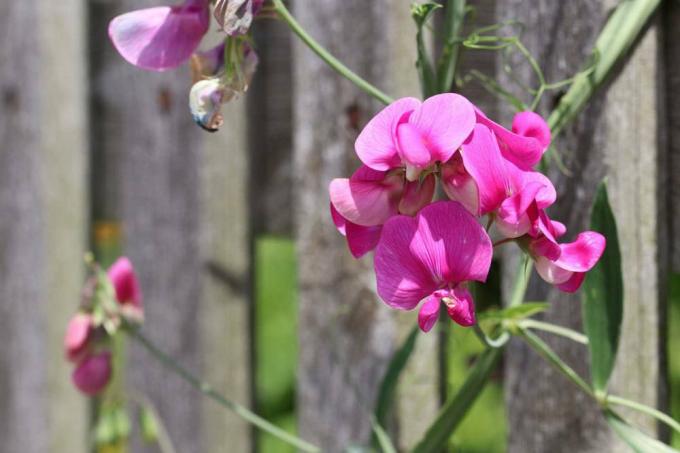
Note: Since the two types of plants are called sweet peas in German, you have to pay attention to the botanical name before buying. With Vicia you get a fast-growing climbing plant, with Lathyrus you get a slow-growing climbing plant with a bewitching scent.
Black-eyed Susan
The black-eyed Susanne is an annual climbing plant that is often kept in pots and, as the name suggests, has black eyes. The orange-yellow petals stand out in stark contrast to the purple corolla tube, which appears black due to its shape. The plant comes from South Africa and can be grown anew every year thanks to a lot of sun and a climbing aid and promises a pleasant number of flowers and rapid growth.
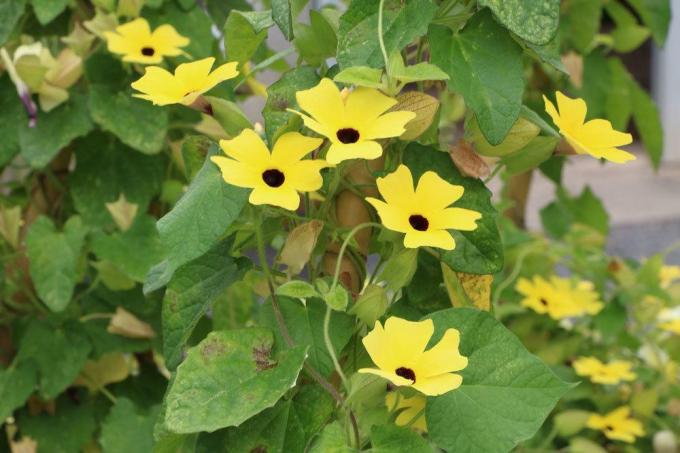
Climbing roses
More than 70 types of ramblerRoses and climbing roses combine in the group of climbing roses, which despite their strong growth do not represent a perennial group. Depending on the species, sizes of up to ten meters in height and width can be achieved, which is especially the case with the Rambler roses. Classic climbing roses usually stay smaller, but bloom more often during the year. Climbing roses are popular as a design element for archways, facades and other elements in the Garden used and pamper the senses with their gentle scent and rose petals that are romantic works. You are spoiled for choice when it comes to climbing roses.

